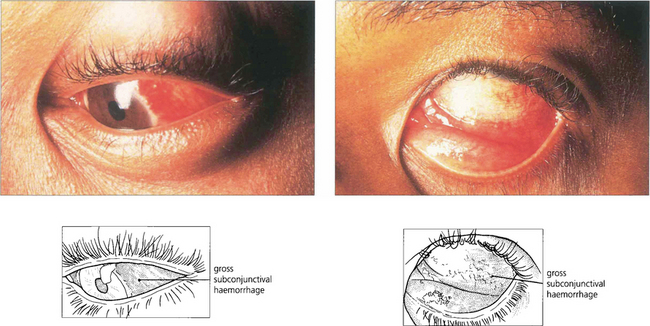4 Infections of the Outer Eye
VIRAL INFECTIONS
ADENOVIRUS
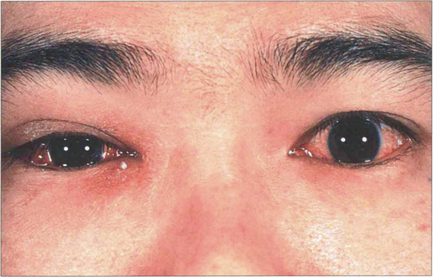
Fig. 4.1 Unilateral or asymmetrical lid swelling and conjunctival inflammation is typical of early infection.
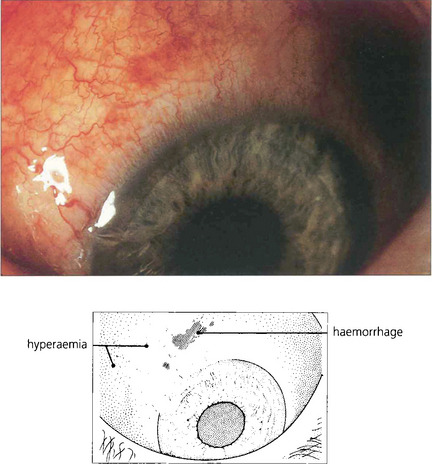
Fig. 4.2 The early stages of adenovirus conjunctivitis are often accompanied by a profuse watery discharge with marked hyperaemia of the bulbar conjunctiva. This patient also has small conjunctival haemorrhages which are sometimes present in the acute phase in patients with severe disease.
A typical case of moderate severity presents with acute bilateral but unequal, swelling and erythema of the eyelids associated with conjunctival inflammation and a watery serous discharge. There may be associated pre-auricular lymphadenopathy, a history of contact with other similar cases or a recent illness of the upper respiratory tract. Although the conjunctival changes resolve over 7–14 days, patients are often left with ocular irritation and discomfort for several weeks. This is due to tear film changes secondary to conjunctival scarring or keratitis.

Fig. 4.3 During the first few days, the palpebral conjunctiva is hyperaemic with a fine papillary reaction. Small amounts of mucopurulent discharge are often produced (right). Similar changes are visible over the upper tarsus (left) where, in severe cases, exudation of fibrin may combine with mucus and lead to pseudo-membrane formation.
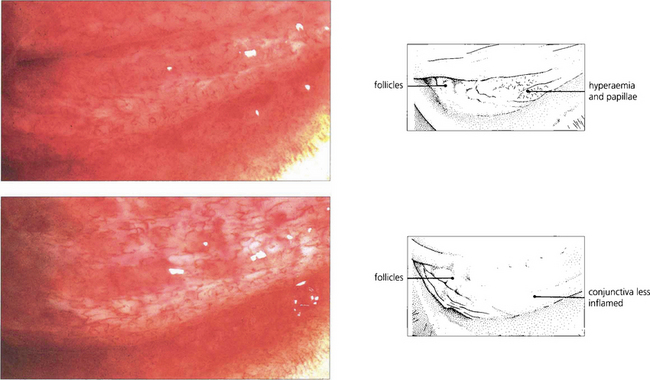
Fig. 4.4 During the first week, small follicles appear in the lower fornix and may later involve the tarsal surface. In the early stages, as in this example, the follicles are greyish-white with slightly raised areas appearing in the subepithelial layers of the inflamed conjunctiva (top). During the second week of the illness the follicles usually persist, although they become more discrete with resolution of the acute inflammatory changes found elsewhere in the conjunctiva. Appearance of the same eye 3 days later (bottom). By the second or third week, the conjunctival disease has usually resolved. The condition is self-limiting, although symptomatic relief may be obtained by the use of topical lubricants.
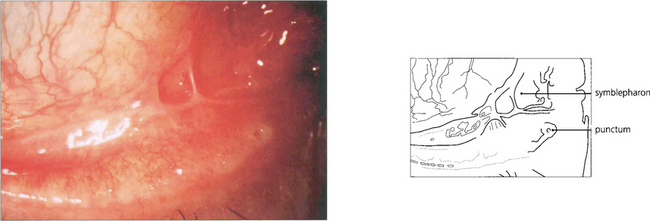
Fig. 4.5 In more severe infections, membranous conjunctivitis may result in sheet conjunctival scarring and symblepharon. This may cause fornix shallowing and long-term discomfort.

Fig. 4.6 Adenoviral keratitis is seen with the more severe forms of the disease and is particularly associated with serotypes 8, 11 and 19. It is first visible as a fine punctate epithelial keratitis that appears during the first week of the disease.

Fig. 4.7 In most cases the superficial keratitis resolves spontaneously but in more severe cases the epithelial lesions gradually coalesce towards the end of the first week to form coarse spots that subsequently become associated with the appearance of subepithelial infiltrates towards the end of the second week (left). The epithelial lesions gradually resolve and as the inflammation disappears the edges of the subepithelial infiltrate harden to produce discrete circular opacities (right).
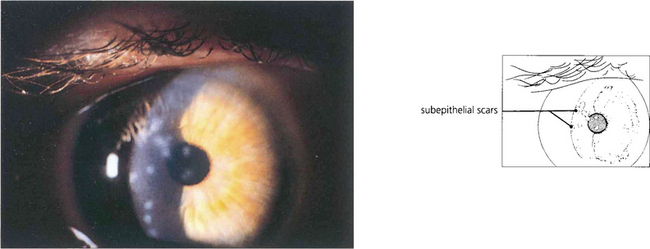
Fig. 4.8 The small circular subepithelial opacities, which are typically placed centrally in adenovirus infections, may persist for many weeks, months or, rarely, years. This patient was photographed 2 years after the initial infection. Although the use of topical steroid preparations results in the temporary disappearance of the corneal lesions, the value of such treatment is limited by the tendency for the opacities to recur following withdrawal of steroids and the potential problems of long-term steroid treatment.
HERPES SIMPLEX
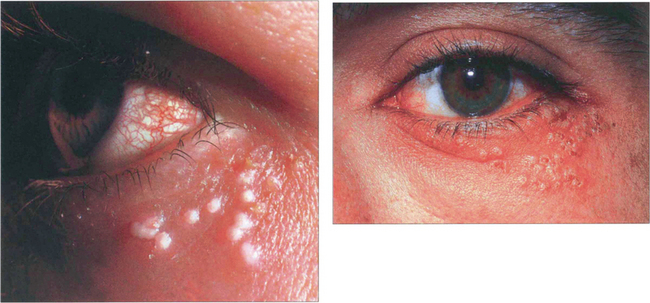
Fig. 4.10 Primary herpetic blepharoconjunctivitis begins as a vesicular eruption with surrounding erythema on the skin of the eyelids. After a few days the lesions become pustular, then crust and ulcerate. Healing takes place during the second and third week. A follicular conjunctivitis is also usually found.
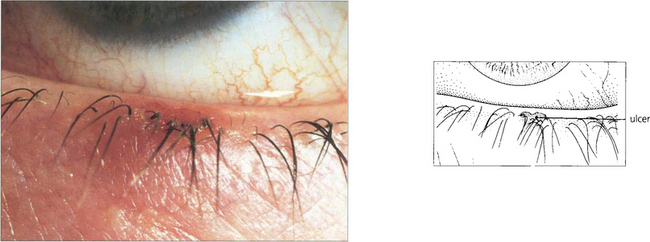
Fig. 4.11 Ulceration of the mucocutaneous junction of the lid margin is common. In recurrent blepharoconjunctivitis due to herpes simplex lid margin ulcers, which will stain with fluorescein, may occur with conjunctivitis in the absence of skin lesions and may be the only evidence of specific herpes simplex infection.
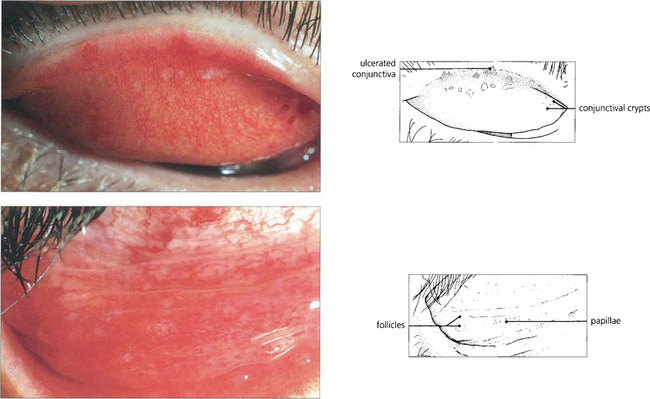
Fig. 4.12 Conjunctivitis is often present with the primary disease when it is invariably associated with a tender, enlarged, pre-auricular lymph node. It is frequently accompanied by purulent discharge and the lower fornix and tarsus show a mixed papillary and follicular reaction indistinguishable from other types of viral conjunctivitis. The upper tarsus shows small areas of conjunctival ulceration near the lid margin that are easily overlooked in the presence of marked hyperaemia. The conjunctivitis responds to treatment with a topical antiviral agent.

Fig. 4.13 Herpes simplex keratitis is usually unilateral. Small single or multiple dendritic ulcers are seen only rarely in the primary disease where, if keratitis is present, it is more commonly a punctate epithelial keratitis. In this example multiple small dendrites stained with Bengal Rose are present over a large area of the corneal surface. Following a primary infection of the eye, herpes simplex virus remains latent within the trigeminal ganglion and is transmitted to the eye by the fifth nerve producing recurrent disease, sometimes in association with stress or systemic illness.
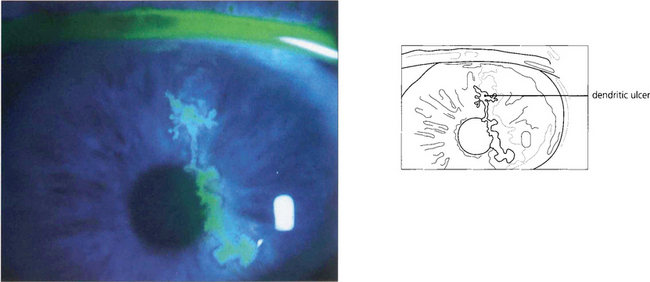
Fig. 4.14 A dendritic ulcer, the hallmark of recurrent corneal herpetic epithelial keratitis. Fluorescein stains the area of epithelial cell loss; disease is limited to the epithelium. Dendritic ulcers heal in about 7 days with a topical antiviral agent.

Fig. 4.15 ‘Amoeboid’ or ‘geographical’ herpetic ulceration almost invariably results from the inadvertent use of topical steroids either for keratoconjunctivitis caused by herpes simplex or for unrecognized epithelial ulceration. Persistent treatment with steroids will lead to corneal destruction and perforation.

Fig. 4.16 Chronic active stromal herpes simplex keratitis involves reactivation of viral replication in the stroma with an associated immune response. This patient has an area of ulceration surrounded by stromal oedema and infiltrate in an old herpetic scar. KP may be seen on the corneal endothelium in the involved area. There is superficial corneal vascularization. Topical steroids with antiviral cover are indicated to suppress the inflammatory reaction and minimize subsequent scarring.
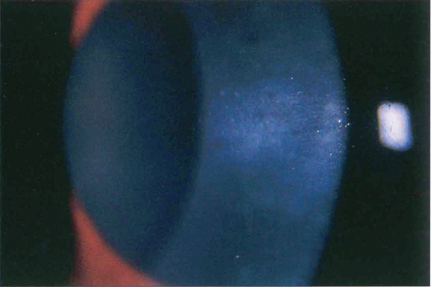
Fig. 4.17 Disciform keratitis can arise with or without a history of previous corneal ulceration and presents as an area of stromal oedema associated with uveitis. These photographs shows an area of diffuse corneal stromal opacification with multiple underlying keratic precipitates centrally, indicating an active keratitis. Treatment with a combination of topical steroid and antiviral will suppress inflammation and subsequent vascularization. However, this treatment may have to be continued for many months to prevent rebound inflammation. Residual stromal scarring is usual. Patients with frequent recurrences of disease benefit from long-term oral antiviral treatment, which reduces the number and severity of relapses.
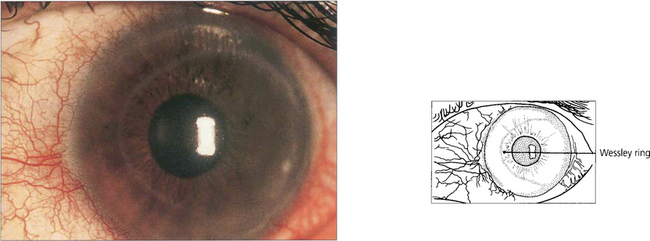
Fig. 4.18 A Wessley ring is another example of an immunological phenomenon occurring in the corneal stroma associated with herpes simplex keratitis. This is formed when soluble antigen diffuses away from the site of infection through the corneal stroma to form a precipitation line where it is neutralized by antibody.

Fig. 4.19 This figure shows an end-stage chronic herpes simplex keratitis with vascularization and lipid deposition in an old stromal scar. Lipid keratopathy may also be seen in any condition that has resulted in the presence of a vascularized scar. A well pronounced arcus senilis is also present.

Fig. 4.20 The histological features of herpes simplex stromal keratitis show an intact corneal epithelium with destruction of parts of Bowman’s layer beneath which there are collections of lymphocytes and plasma cells. Vascularization of the corneal stroma is also evident with loss of the normal pattern of corneal lamellae.
HERPES ZOSTER
Herpes zoster ophthalmicus results from the activation of latent varicella zoster virus in the trigeminal ganglion with neuronal spread of virus through the first (ophthalmic) division of the nerve. The resulting vesicular eruption follows the distribution of the affected dermatome and may be preceded by a few days of neuralgic pain in the same area. A wide spectrum of ocular involvement may occur, including conjunctivitis, keratitis, corneal anaesthesia, iritis (see Ch. 10
Stay updated, free articles. Join our Telegram channel

Full access? Get Clinical Tree


